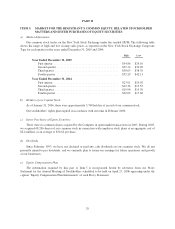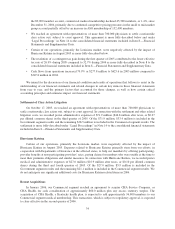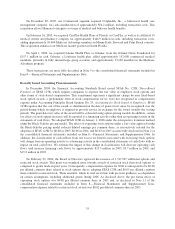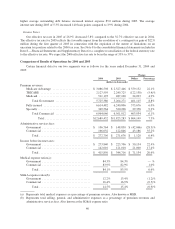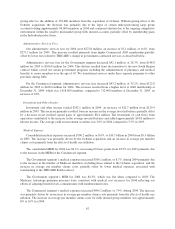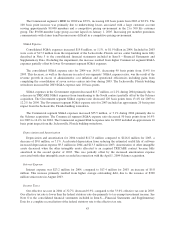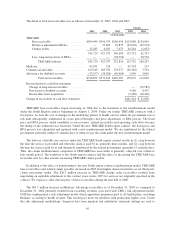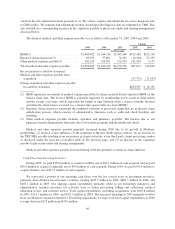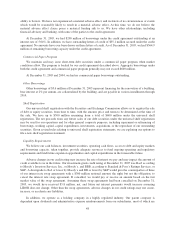Humana 2005 Annual Report Download - page 48
Download and view the complete annual report
Please find page 48 of the 2005 Humana annual report below. You can navigate through the pages in the report by either clicking on the pages listed below, or by using the keyword search tool below to find specific information within the annual report.Administrative Services Fees
Our administrative services fees for 2005 were $259.4 million, a decrease of $13.4 million, or 4.9%, from
$272.8 million for 2004.
Administrative services fees for the Government segment decreased $56.7 million, or 53.1%, from $106.8
million for 2004 to $50.1 million for 2005. This decline resulted from the transition to the new South Region
contract which carved out certain government programs including the administration of pharmacy and medical
benefits to senior members over the age of 65. We transitioned services under these separate programs to other
providers during 2004.
For the Commercial segment, administrative services fees increased $43.4 million, or 26.1%, from $166.0
million for 2004 to $209.4 million for 2005. This increase resulted from increased membership and higher
average per member fees. ASO membership of 1,171,000 members at December 31, 2005 increased 15.0%
compared to 1,018,600 at December 31, 2004. Average per member fees increased approximately 8% in 2005.
Investment and Other Income
Investment and other income totaled $157.1 million in 2005, an increase of $15.0 million from $142.1
million in 2004. This increase primarily was attributable to increased investment income from higher interest
rates and average invested balances offset by lower capital gains. The average yield on investment securities was
4.0% in 2005 compared to 3.6% in 2004. The investment of cash flows from operations contributed to the
increase in the average invested balance and added approximately $7.0 million to interest income. Net realized
capital gains of $18.3 million in 2005 decreased $9.9 million from $28.2 million in 2004. As of December 31,
2005, we had an unrealized gain of $52.3 million related to a venture capital investment. We realized this gain in
the first quarter of 2006 with the sale of this venture capital investment.
Medical Expense
Consolidated medical expenses increased $981.8 million or 9.2% during 2005. The increase was primarily
driven by the increase in average per member claims costs primarily from the effects of health care inflation and
incremental medical expenses related to the CarePlus acquisition.
The medical expense ratio, or MER, which is computed by taking total medical expenses as a percentage of
premium revenues, represents a key industry statistic used to measure underwriting profitability.
The consolidated MER for 2005 was 83.2%, decreasing 90 basis points from 84.1% for 2004 due to
improvements in both the Commercial and Government segments as further discussed below. The 2005
consolidated MER includes 20 basis points for expenses associated with Hurricane Katrina.
The Government segment’s medical expenses increased $1.4 billion, or 30.0% during 2005 primarily due to
the increase in average per member claims costs and the increase in the number of Medicare members, including
those related to the CarePlus acquisition. The increase in average per member claims costs for Medicare
approximated 8% to 10% during 2005.
The Government segment’s MER for 2005 was 83.1%, a 120 basis point decrease from the 2004 rate of
84.3%. Excluding a 10 basis point increase in the 2005 MER from Hurricane Katrina, the decrease was primarily
attributable to the increase in Medicare revenues as a percentage of total Government segment revenues and
average per member Medicare premiums outpacing average per member Medicare claim costs.
The Commercial segment’s medical expenses decreased $465.2 million, or 8.0%. This decrease primarily
results from the decrease in fully insured group membership partially offset by the increase in average per
member claims costs. The increase in average per member claims costs for fully insured group members was
approximately 7% to 9% for 2005.
38



